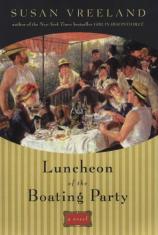Luncheon of the Boating Party
Review
Luncheon of the Boating Party
In
previous novels, Susan Vreeland has brought artists as diverse as
Jan Vermeer, Emily Carr and Artemisia Gentileschi to life in the
pages of her novels, often focusing on the fictional circumstances
surrounding their masterworks. Now Vreeland turns her attention to
Impressionist master Pierre Auguste Renoir and the genesis of his
most famous work, which depicts a group of 14 merrymakers enjoying
lunch on the banks of the Seine outside Paris.
At the novel's opening, Renoir is frustrated; the Impressionist
group seems to be dividing against itself, conflicted over the
question of whether to exhibit paintings in the more
establishment-sanctioned Salon. What's more, Renoir is outraged by
an essay written by critic Emile Zola, who writes, "Despite their
[the Impressionists'] struggle, they have not reached their goal;
they remain inferior to what they undertake; they stammer without
being able to find words."
Renoir, convinced that he is the one to prove Zola wrong and
finally get a major Impressionist work shown at the Salon, sets
about to paint a picture that will define la vie moderne
(modern life): young people, enjoying leisure time at a riverside
cafe. He envisions a monumental painting that will combine
portraiture, group dynamics and still life in a composition that is
both an homage to classical masters and a vision for the future of
painting.
But for Renoir, realizing his vision will hardly be simple. There's
the matter of assembling an appropriate group of models, which
include country folk, fellow artists, writers and a former mistress
or two. There's the fact that Renoir's right arm is in a cast
following a bicycling accident. And there's the eternal problems of
time and money, both of which might run out before Renoir has been
able to capture the elusive quality of summer light on the
Seine.
Vreeland's writing here is as engaging as ever, particularly when
she broadens her scope to focus on the various figures in the
painting, revealing their own stories and connections even as she
focuses primarily on Renoir's own vision and motivation. The scenes
that take place during each Sunday's modeling sessions are
particularly delightful, as these young Parisians engage in witty,
bawdy banter while Renoir attempts to capture their frivolity and
spirit with his brush.
Vreeland's portrayal of Renoir himself is a fascinating character
study. She plays with his reputation as a philanderer, giving his
well-known affection for his models substance and depth even as the
easily influenced painter falls hard for his newest models: "A
painter of women was what he wanted to be known as, but that meant
having a steady stream of models to inspire him, to make his pulse
pound with the urgency to paint what he saw, what he felt in his
body, what he wanted to touch."
Readers familiar with Renoir's work and that of his fellow
Impressionists will glean the most from Vreeland's latest novel,
and will likely pick up on many of her allusions to other artistic
works (some of which are reproduced in color plates). But even
readers new to Renoir's life and work will come away from LUNCHEON
OF THE BOATING PARTY with a great appreciation for these complex,
accomplished group portraits --- both Renoir's and
Vreeland's.
Reviewed by Norah Piehl on January 6, 2011
Luncheon of the Boating Party
- Publication Date: May 3, 2007
- Genres: Fiction, Historical Fiction
- Hardcover: 448 pages
- Publisher: Viking Adult
- ISBN-10: 0670038547
- ISBN-13: 9780670038541





